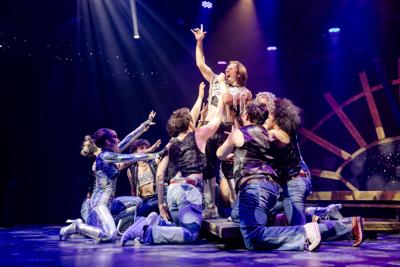John Saunders’ audacious direction of Andrew Lloyd Webber and Tim Rice’s iconic rock opera, “Jesus Christ Superstar,” at the Mac-Haydn Theatre, delivers a production that is as bold as it is unforgettable, commanding attention from its very first note. This vibrant staging challenges traditional interpretations, pushing boundaries with an unyielding energy that resonates throughout the entire performance, making it a compelling subject for any theatre review.
From the moment the lights dim, Saunders’ vision is clear: a “Superstar” that embraces intensity and raw power, often forgoing moments of subtle tenderness for a more visceral impact. This approach immediately distinguishes the Mac-Haydn Theatre production, inviting audiences into a dynamic narrative that prioritizes urgency and a fresh perspective on a classic, elevating the overall musical production.
Originally conceived as a groundbreaking album musical that achieved significant commercial success, “Jesus Christ Superstar” transitioned to the stage with a daring and sometimes controversial Broadway debut in 1971. The Mac-Haydn’s take acknowledges this rebellious spirit, weaving it into a contemporary framework that speaks to modern sensibilities while honoring its historical roots, showcasing exceptional arts criticism potential.
The narrative, loosely drawn from the Gospel accounts of Matthew, Mark, Luke, and John, meticulously chronicles the Passion of Jesus, yet uniquely frames the complex relationships through the lens of Judas Iscariot. This focus on Judas’s internal struggle and ultimate betrayal provides a compelling and often poignant foundation for the dramatic unfolding of events within this timeless rock opera.
Kaitlyn Frank’s purposefully frenetic choreography complements Saunders’ staging, depicting the mob and disciples moving as a unified, almost primal force, imbued with youthful, unabandoned energy. The visual design contributes to a striking sense of timelessness, with elements of Roman fashion juxtaposed against the eerily futuristic attire of Caiaphas and the priests, creating a visual tapestry that is both historical and avant-garde in this particular musical production.
Perhaps the most resounding aspect of this Mac-Haydn Theatre production is the extraordinary musicianship and vocal prowess displayed by the cast. This “Jesus Christ Superstar” stands as a masterclass in vocal range and boundary-pushing performances, from Beaulieu-Shaffer’s astounding bass and Caldwell’s stunning baritone in “Pilate’s Dream,” to Cydney Gleckner’s lyrical tones in “I Don’t Know How to Love Him,” and Jared Goodwin’s astonishing, seemingly limitless falsetto as Jesus, making it a highlight in any theatre review.
Despite its many triumphs, the production is not without its imperfections, with certain opportunities, such as Mikel Hunter’s cabaret-style interpretation of “Herod’s Song,” feeling somewhat misplaced. There are instances where the direction seems exploratory, as if Saunders is thinking aloud through the staging. Yet, these minor stumbles do not detract significantly from the overall impact of a “Jesus Christ Superstar” that feels distinctly relevant to our current era, worthy of detailed arts criticism.
Ultimately, the Mac-Haydn Theatre‘s “Jesus Christ Superstar” delivers a high-energy, visually striking, and vocally magnificent rock opera experience. While perhaps not a definitive rendition, it is a brave reimagining that breathes fresh life into a beloved classic, offering audiences a compelling and thought-provoking theatrical event and a strong contender for significant musical production accolades.






Leave a Reply